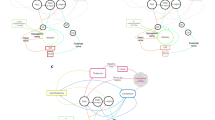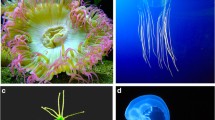Abstract
It has recently been shown that spinal neurons in Xenopus embryos receive cholinergic and electrotonic excitation during swimming, in addition to the well documented excitatory amino acid (EAA)-mediated excitation. We have now examined the composition of the excitatory drive during swimming in embryos of two further amphibian species, Rana and Bufo, which have somewhat different motor patterns. Localised applications of antagonists show that presumed motoneurons in Rana and Bufo embryos receive both cholinergic and EAA input during swimming. There is also a further chemical component which is blocked by Cd2+ and a small Cd2+-insensitive component, which is usually non-rhythmic. Rhythmic Cd2+-insensitive components, presumed to be phasic electrotonic potentials, were only seen in a small proportion of Bufo neurons and in no Rana neurons. While EAA and cholinergic inputs therefore appear to be consistent features of excitatory drive for swimming in amphibian embryo motoneurons, electrotonic input apparently occurs less commonly. Antagonist specificity was tested using applied agonists in Rana. Results of these tests also suggested that the further, unidentified Cd2+-sensitive component seen during swimming could represent an incomplete block of AMPA receptor-mediated excitation.
Similar content being viewed by others
Abbreviations
- AMPA :
-
α-Amino-3-hydroxy-5-methyl- 4-isoxazolepropionic acid
- CNQX :
-
6-Cyano-7- nitroquinoxaline-2,3-dione
- D-AP5 :
-
D(-)-2- Amino-5-phosphonopentanoic acid
- DHβE :
-
Dihydro-β-erythroidin
- DMPP :
-
1,1-dimethyl-4- phenylpiperazinium
- HEPES :
-
N-[2-hydroxyethyl] piperazine-N′-[2-ethanesulphonic acid]
- NMDA :
-
N-methyl-D-aspartic acid
References
Alford S, Grillner S (1990) CNQX and DNQX block non-NMDA synaptic transmission but not NMDA-evoked locomotion in lamprey spinal cord. Brain Res 506: 297–302
Alford S, Williams TL (1989) Endogenous activation of glycine and NMDA receptors in lamprey spinal cord during fictive locomotion. J Neurosci 9: 2792–2800
Barry MJ, O'Donovan MJ (1987) The effects of excitatory amino acids and their antagonists on the generation of motor activity in the isolated chick spinal cord. Dev Brain Res 36: 271–276
Birch PJ, Grossman CJ, Hayes AG (1988) 6,7-Dinitro-quinoxaline2,3-dion and 6-nitro, 7-cyano-quinoxaline-2,3-dion antagonize responses to NMDA in the rat spinal cord via an action at the strychnine-insensitive glycine receptor. Eur J Pharmacol 156: 177–180
Cazalets JR, Sqalli-Houssaini Y, Clarac F (1992) Activation of the central pattern generators for locomotion by serotonin and excitatory amino acids in neonatal rat. J Physiol 455: 187–204
Cull-Candy SG, Herron CE (1989) Interaction of quinoxalinedion and glycine with the NMDA response in rat isolated cerebellar granule neurons. J Physiol (Lond) 415: 44P
Dale N (1991) The isolation and identification of spinal neurons that control movement in the Xenopus embryo. Europ J Neurosci 3: 1025–1035
Dale N, Grillner S (1986) Dual-component synaptic potentials in the lamprey mediated by excitatory amino acid receptors. J Neurosci 6: 2653–2661
Dale N, Roberts A (1984) Excitatory amino acid receptors in Xenopus embryo spinal cord and their role in the activation of swimming. J Physiol (Lond) 348: 527–543
Dale N, Roberts A (1985) Dual-component amino-acid-mediated synaptic potentials: excitatory drive for swimming in Xenopus embryos. J Physiol (Lond) 363: 35–59
Douglas JR, Noga BR, Dai X, Jordan LM (1992) The effects of intrathecal administration of excitatory amino acid agonists and antagonists on the initiation of locomotion in the adult cat. J Neurosci 13: 990–1000
Gosner KL (1960) A simplified table for staging anuran embryos and larvae with notes on identification. Herpetologica 16: 183–190
Harper CE, Roberts A (1993) Spinal cord neuron classes in embryos of the smooth newt Triturus vulgaris: a horseradish peroxidase and immunocytochemical study. Phil Trans R Soc Lond B 340: 141–160
Kudo N, Yamada T (1987) N-Methyl-D,L-aspartate-induced locomotor activity in a spinal cord-hindlimb muscles preparation of the newborn rat studied in vitro. Neurosci Lett 75: 43–48
Nieuwkoop PD, Faber J (1956) Normal Tables of Xenopus laevis (Daudin). North-Holland, Amsterdam
Perrins R, Roberts A (1994) Nicotinic and muscarinic ACh receptors in rhythmically active spinal neurons in the Xenopus laevis embryo. J Physiol (Lond) 478: 221–228
Perrins R, Roberts A (1995a) Cholinergic and electrical synapses between synergistic spinal motoneurones in the Xenopus laevis embryo. J Physiol (Lond) 485: 135–144
Perrins R, Roberts A (1995b) Cholinergic and electrical motoneuron-to-motoneuron synapses contribute to on-cycle excitation during swimming in Xenopus embryos. J Neurophysiol 73: 1005–1012
Perrins R, Roberts A (1995c) Cholinergic contribution to excitation in a spinal locomotor central pattern generator in Xenopus embryos. J Neurophysiol 73: 1013–1019
Perrins R, Soffe SR (1996) Local effects of glycinergic inhibition in the spinal cord motor systems for swimming in amphibian embryos. J Neurophysiol (in press)
Roberts A, Clarke JDW (1982) The neuroanatomy of an amphibian embryo spinal cord. Phil Trans R Soc B 296: 195–212
Roberts A, Tunstall MJ (1990) Mutual re-excitation with postinhibitory rebound: a simulation study on the mechanisms for locomotor rhythm generation in the spinal cord of Xenopus embryos. Europ J Neurosci 2: 11–23
Roberts A, Soffe SR, Dale N (1986) Spinal interneurones and swimming in frog embryos. In: Grillner S, Stein PSG, Stuart D, Forssberg H, Herman RM (eds) Neurobiology of vertebrate locomotion. Macmillan, London, pp 279–306
Roberts A, Tunstall MJ, Wolf E (1995) Properties of networks controlling locomotion and significance of voltage dependency of NMDA channels: simulation study of rhythm generation sustained by positive feedback. J Neurophysiol 73: 485–495
Soffe SR (1987) Ionic and pharmacological properties of reciprocal inhibition in Xenopus embryo motoneurones. J Physiol (Lond) 382: 463–473
Soffe SR (1990) Active and passive membrane properties of spinal cord neurons which are rhythmically active during swimming in Xenopus embryos. Europ J Neurosci 2: 1–10
Soffe SR (1991) Centrally generated rhythmic and non-rhythmic behavioural responses in Rana temporaria embryos. J Exp Biol 156: 81–99
Soffe SR (1993) Two distinct rhythmic motor patterns are driven by common premotor and motor neurons in a simple vertebrate spinal cord. J Neurosci 13: 4456–4469
Soffe SR, Sillar KT (1991) Pattern of synaptic drive to ventrally located spinal neurones in Rana temporaria embryos during rhythmic and non-rhythmic motor responses. J Exp Biol 156: 101–118
Verdoorn TA, Kleckner NW, Dingledine R (1989) N-methyl-Daspartate, glycine and quisqualate/kainate receptors expressed in Xenopus oocytes — antagonist responses. Mol Pharmacol 35: 360–368
Wallén P, Grafe P, Grillner S (1984) Phasic variations of extracellular potassium during fictive swimming in the lamprey spinal cord in vitro. Acta Scand Physiol 120: 457–463
Author information
Authors and Affiliations
Rights and permissions
About this article
Cite this article
Perrins, R., Soffe, S.R. Composition of the excitatory drive during swimming in two amphibian embryos: Rana and Bufo . J Comp Physiol A 179, 563–573 (1996). https://doi.org/10.1007/BF00192322
Accepted:
Issue Date:
DOI: https://doi.org/10.1007/BF00192322




